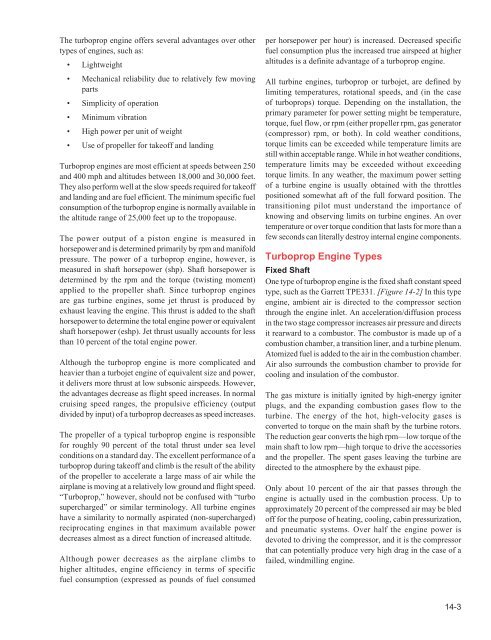You also want an ePaper? Increase the reach of your titles
YUMPU automatically turns print PDFs into web optimized ePapers that Google loves.
The turboprop engine offers several advantages over other<br />
types of engines, such as:<br />
• Lightweight<br />
• Mechanical reliability due to relatively few moving<br />
parts<br />
• Simplicity of operation<br />
• Minimum vibration<br />
• High power per unit of weight<br />
• Use of propeller for takeoff and landing<br />
Turboprop engines are most efficient at speeds between 250<br />
and 400 mph and altitudes between 18,000 and 30,000 feet.<br />
They also perform well at the slow speeds required for takeoff<br />
and landing and are fuel efficient. The minimum specific fuel<br />
consumption of the turboprop engine is normally available in<br />
the altitude range of 25,000 feet up to the tropopause.<br />
The power output of a piston engine is measured in<br />
horsepower and is determined primarily by rpm and manifold<br />
pressure. The power of a turboprop engine, however, is<br />
measured in shaft horsepower (shp). Shaft horsepower is<br />
determined by the rpm and the torque (twisting moment)<br />
applied to the propeller shaft. Since turboprop engines<br />
are gas turbine engines, some jet thrust is produced by<br />
exhaust leaving the engine. This thrust is added to the shaft<br />
horsepower to determine the total engine power or equivalent<br />
shaft horsepower (eshp). Jet thrust usually accounts for less<br />
than 10 percent of the total engine power.<br />
Although the turboprop engine is more complicated and<br />
heavier than a turbojet engine of equivalent size and power,<br />
it delivers more thrust at low subsonic airspeeds. However,<br />
the advantages decrease as flight speed increases. In normal<br />
cruising speed ranges, the propulsive efficiency (output<br />
divided by input) of a turboprop decreases as speed increases.<br />
The propeller of a typical turboprop engine is responsible<br />
for roughly 90 percent of the total thrust under sea level<br />
conditions on a standard day. The excellent performance of a<br />
turboprop during takeoff and climb is the result of the ability<br />
of the propeller to accelerate a large mass of air while the<br />
airplane is moving at a relatively low ground and flight speed.<br />
“Turboprop,” however, should not be confused with “turbo<br />
supercharged” or similar terminology. All turbine engines<br />
have a similarity to normally aspirated (non-supercharged)<br />
reciprocating engines in that maximum available power<br />
decreases almost as a direct function of increased altitude.<br />
Although power decreases as the airplane climbs to<br />
higher altitudes, engine efficiency in terms of specific<br />
fuel consumption (expressed as pounds of fuel consumed<br />
per horsepower per hour) is increased. Decreased specific<br />
fuel consumption plus the increased true airspeed at higher<br />
altitudes is a definite advantage of a turboprop engine.<br />
All turbine engines, turboprop or turbojet, are defined by<br />
limiting temperatures, rotational speeds, and (in the case<br />
of turboprops) torque. Depending on the installation, the<br />
primary parameter for power setting might be temperature,<br />
torque, fuel flow, or rpm (either propeller rpm, gas generator<br />
(compressor) rpm, or both). In cold weather conditions,<br />
torque limits can be exceeded while temperature limits are<br />
still within acceptable range. While in hot weather conditions,<br />
temperature limits may be exceeded without exceeding<br />
torque limits. In any weather, the maximum power setting<br />
of a turbine engine is usually obtained with the throttles<br />
positioned somewhat aft of the full forward position. The<br />
transitioning pilot must understand the importance of<br />
knowing and observing limits on turbine engines. An over<br />
temperature or over torque condition that lasts for more than a<br />
few seconds can literally destroy internal engine components.<br />
Turboprop Engine Types<br />
Fixed Shaft<br />
One type of turboprop engine is the fixed shaft constant speed<br />
type, such as the Garrett TPE331. [Figure 14-2] In this type<br />
engine, ambient air is directed to the compressor section<br />
through the engine inlet. An acceleration/diffusion process<br />
in the two stage compressor increases air pressure and directs<br />
it rearward to a combustor. The combustor is made up of a<br />
combustion chamber, a transition liner, and a turbine plenum.<br />
Atomized fuel is added to the air in the combustion chamber.<br />
Air also surrounds the combustion chamber to provide for<br />
cooling and insulation of the combustor.<br />
The gas mixture is initially ignited by high-energy igniter<br />
plugs, and the expanding combustion gases flow to the<br />
turbine. The energy of the hot, high-velocity gases is<br />
converted to torque on the main shaft by the turbine rotors.<br />
The reduction gear converts the high rpm—low torque of the<br />
main shaft to low rpm—high torque to drive the accessories<br />
and the propeller. The spent gases leaving the turbine are<br />
directed to the atmosphere by the exhaust pipe.<br />
Only about 10 percent of the air that passes through the<br />
engine is actually used in the combustion process. Up to<br />
approximately 20 percent of the compressed air may be bled<br />
off for the purpose of heating, cooling, cabin pressurization,<br />
and pneumatic systems. Over half the engine power is<br />
devoted to driving the compressor, and it is the compressor<br />
that can potentially produce very high drag in the case of a<br />
failed, windmilling engine.<br />
14-3


